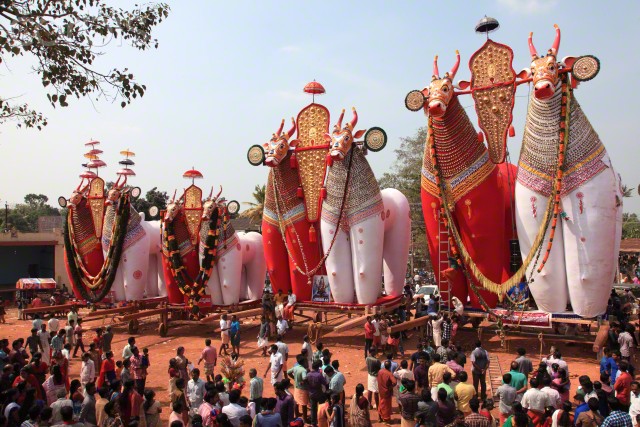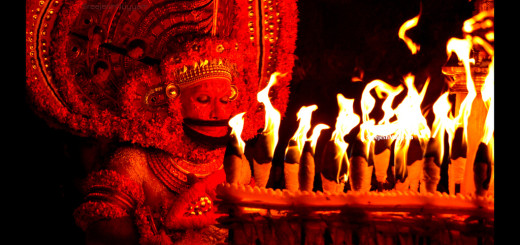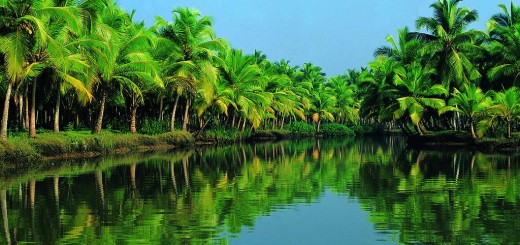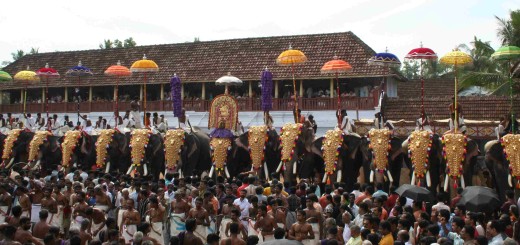Kerala Temple Festivals: Bull Effigies, Colorful Parades And Traditional Orchestra

Huge decorated bull effigies displayed in a procession known as ‘Kettukazhcha’ during the festival at Nooranad Padanilam. Some temples use elephants for festivals; others use effigies of bulls or horses.
Kerala has a rich tradition of temple festivals. These are colorful events that bring entire neighborhoods to the temple. Most temple festivals involve decorated elephants. Some have effigies of bulls instead.
Some temple festivals held in the districts of Thrissur and Palakkad are known as Vela. Generally speaking, a vela does not involve elephants. Instead, festooned effigies of bulls or horses are used. A vela is as grant a festival as a pooram. Velas are usually held at temples dedicated to goddesses. Some goddess temples have poorams with elephants. Sometimes a vela is also celebrated with elephants. This is basically a matter of custom and tradition.
Each desham in Kerala has its own deity. A desham is a bit like a county. It consists of several villages. The deity is usually a goddess called Bhagavathi or Amma (mother). While these goddesses are believed to be the incarnations of Lakshmi, Parvathi or Saraswathi, they are known by the name of the place where they reside. For example, the goddess at Chinakkathoor kavu is called Chinakkathoor Bhagavathi or Chinakkathoor kavilamma (the mother goddess of Chinakkathoor).
On the day of the festival, there will be colorful processions from each village to the temple. If the festival involves bulls, festival committees of each village will bring their own bull procession to the temple. These aren’t real bulls, but they look better than the real ones because of their ornaments and other decorations. Since they can’t walk on their own, they are mounted on a frame made by bamboo poles. A group of people will carry these bulls on their shoulders and walk towards the temple. They will be accompanied by their own bands of traditional orchestra and other performers. Thousands of people participate in these processions.
On the day of the festival, people will start flocking to the temple in the morning itself. Special pujas are held. The actual festivities begin in the afternoon. By 2 pm, colorful processions involving decorated bulls or horses will start moving towards the temple from different villages participating in the festival. They will reach the temple by 5 pm. Once the procession reaches the temple, people carrying the bulls or horses will bring them closer to the sanctum so that they can offer tribute to the goddess. This actually involves a bit of running with the bulls. Once this ceremony is over, they will retreat to the background where they will form a magnificent lineup with other bulls in the procession. This is a grand spectacle. The festivities end with the fireworks which are usually held late in the night.
The festivities usually begin with the hoisting of the festival flag. In the case of one-day festivals, the flag is hoisted one week in advance. This is called kotiyettam. Once the flag is hoisted, the festival is declared and the whole desham plunges into the festive spirit. People do not normally visit faraway places during these 7 days. Visiting is okay, but sleeping at another place that does not belong to the desham is considered as inauspicious. These beliefs are changing slowly, but people still try to avoid long distance travel during the seven days prior to the festival.
Temple festivals are expensive affairs. Costs are usually borne by the temples and the festival committees. Each village will have their own committees. In the days prior to the festival, they will go from home to home collecting rice, oil and other valuable items to cover the expenses. People also make rich donations to these committees. There is friendly competition between the participating villages. Each one wants their festivities to be the best. For the spectators, these festivals are grand spectacles they will remember for a long time.
If you are in Kerala between February and May, don’t miss these festivals. There are several of them especially in the districts of Thrissur and Palakkad.


